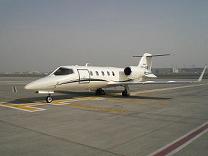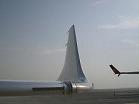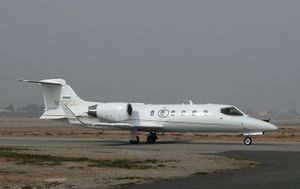PlaneSpottingWorld welcomes all new members! Please gives your ideas at the Terminal.
Learjet 31
| Learjet 31 | |
|---|---|
| Learjet 31A | |
| Type | Business jet |
| Manufacturer | Learjet |
| Maiden flight | May 11, 1987 |
| Primary users | Private Military NASA |
The Learjet 31 is a ten seat (two crew and eight passengers) twin-engined, high speed business jet. Manufactured by Learjet (a subsidiary of Bombardier) as the successor to the Learjet 29.
Contents
History
The first flight of the LJ31 took place on 11 May 1987. The Learjet 31A variant was introduced in October 1990. This version featured increased cruising speed, a digital avionics system with EFIS von AlliedSignal (today Honeywell) and an instrument panel layout change. The nose gear wheel is steered by a Steer by Wire system. The windshield could be heated electrically.
The Learjet 31ER with increased range was produced.
The first 31A serial number 31A-035 entered service 15 August 1991. The last 31A delivered, serial number 31A-242 was delivered 1st of October 2003.
Variants
Learjet 31
The Learjet Model 31 is, arguably, the ultimate realization of the original Learjet series (dating back to the model 23 of 1963). Essentially combining the fuselage and engines of the model 35/36 with the “Longhorn” wing of the 28, 29 and 50 models, results in performance which is equaled by few aircraft. Normal cruise altitudes range from 41,000 to 47,000 feet (12,500-14,900 m) and the aircraft’s maximum cruise altitude of 51,000 feet (15,500 m) is a distinction shared by only a handful of civil aircraft. Improvements over earlier models, such as “Delta-Fins” and a “Ski-Locker” increased the utility and improved the performance of the model 31. Addition of Delta-Fins at the bottom of the empennage simplified the certification process of the aircraft by eliminating the need for a “stick pusher” stall avoidance device. Increased directional stability, as a result of the Delta-Fins, was also a welcome benefit.
Learjet 31A
The Learjet 31A was announced in 1990 as a replacement after building 38 Learjet 31’s. Note, the last six 31’s, 31-033, 31-033A, 31-033B, 31-033C, 31-033D, 31-034 were equipped with Honeywell avionics systems for Singapore Airlines flight training and have a unique cockpit. The model 31A boasted numerous modifications, however the most notable changes would take place on the flight deck. Key modifications and updates to the model 31A cockpit and avionics include; a Bendix King (now Honeywell after the merger with Allied Signal) Electronic Flight Information System 50, with Universal 1M, 1B and 1C flight management system, a dual KFC 3100 two-axis autopilot and flight director with yaw damper, and dual Bendix King (Radios sold to Chelton Avionics when Allied Signal combined with Honeywell) VCS-40A com units, VN-411B Series III navigation receivers.
In the year 2000 the Learjet 31A was again revised. The starting and landing load were raised. The engines received a digital control (EICAS), the thrust reversing were now in series inserted. The air conditioning system was divided in 2 zones, cockpit and cab. The bearing area ends were provided with Winglets, in order to improve the handling in large heights and at high speed.
Specifications
General
- Crew: 2
- Capacity: 8 passengers, or six, "in comfort"
- Length: 47 ft 8 in (14.54 m)
- Wingspan: 43 ft 8 in (13.30 m)
- Height: 12 ft 3 in (3.73 m)
- Wing area: 264.8 ft² (24.6 m²)
- Empty weight: 11,100 lb (5,035 kg)
- Maximum takeoff weights:
- Standard 15,500 lb (7,031 kg)
- Optional 16,500 lb (7,484 kg)
- Optional 17,000 lb (7,711 kg)
- Optional 17,700 lb (8,028 kg)
- Powerplant: (2) Garrett TFE-731-2 (3,500 lbf/15.56 kN at take-off)
Performance
- Maximum speed: 529 mph (851 km/h)
- Cruise speed: 506 mph (814 km/h)
- Range: 1455 NM (2695 km) (with NBAA IFR reserves, ISA, with 4 passengers)
- Service ceiling: 51,000 ft (15,545 m)
- Rate of climb (at sea level): 5,100 feet/min (25.9 m/s)
- Balanced field length (at sea level, ISA and max. weight) 3,500 feet (1,060 m)
- Landing distance (at max. landing weight): 2,870 feet (875 m)
Lists relating to aviation | |
|---|---|
| General | Timeline of aviation · Aircraft · Aircraft manufacturers · Aircraft engines · Aircraft engine manufacturers · Airports · Airlines |
| Military | Air forces · Aircraft weapons · Missiles · Unmanned aerial vehicles (UAVs) · Experimental aircraft |
| Notable incidents and accidents | Military aviation · Airliners · General aviation · Famous aviation-related deaths |
| Records | Flight airspeed record · Flight distance record · Flight altitude record · Flight endurance record · Most produced aircraft |




